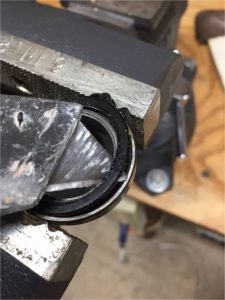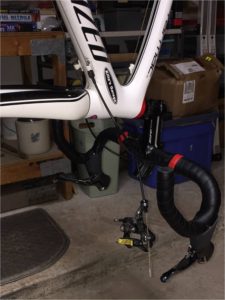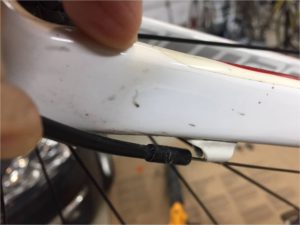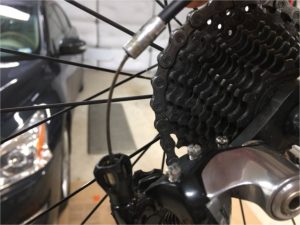My heart goes out to those of you that got floodwaters in your homes from Hurricanes Harvey and Irma. I was lucky enough to avoid flooding at my house, though I live within a mile of devastated neighborhoods. I’ve been reluctant to post on my blog, and we’ve all been busy helping out around here, ripping out sheetrock and drying things out.
I hope you don’t need information on post-flood bicycle recovery, but I’m sure some of you do. Here are my thoughts on drying out a flood-drenched bike.
Starting from the bottom up:
Rims: Water can collect in rims even if you’ve simply ridden in the rain. It gets on the spokes and gets slung outward through the spoke holes as you ride. If floodwater got up to the spokes, it’s a good bet there’s water in your rims. Take the tires off. Take the rim strips off. Stand the wheels with the valve stem at the bottom to drain. See my post on easy tire changing.
Don’t be alarmed. I’m about to recommend WD40, a product I normally keep away from my bikes.
Pedals: Remove the pedals and re-grease the pedal/crank threads. The left side is left handed. Remember “Back-off”. Spray the pedals with WD40 or some other non-water based spray cleaner. Get it into where the springs are. Follow up with spray lithium grease. I get my spray lithium at Lowe’s in the tools area. Bearings are typically serviceable, but disassembly varies. Keep in mind some of the threads that hold pedals together are left handed. Speedplay pedals, having no moving parts except the bearings, simplify pedal maintenance greatly. Just remove the small screw on the outboard end and pump a little grease in. Personally I use cheaper Shimano pedals and replace them when they give me trouble.
Bottom bracket: Remove the crank. If you have a threaded bottom bracket, remove at least one side to allow water to drain from the frame. (On the bottom bracket, the right side is left handed, unless it’s Italian threaded.) You can pop the outer bearing seals off most bottom bracket bearings with a sharp-pointed blade to check the bearings for water intrusion. The seals will pop back on. Do I have to tell you to be careful to avoid cutting yourself doing this? 
Chain: This is probably a good time to change your chain, but if it’s not rusty and you want to salvage it, douse it with WD40 or your favorite chain cleaner, wipe it down, and lube it with your favorite oil.
Derailleurs: Spray them down with WD40 and wipe them off really well.
Cables: If water has gotten into your cables and stayed there for any length of time, you should just plan on changing them. If your cables are external and your cable stops are slotted, you can unhook the rear derailleur housing from the chainstay stop and slide the housing up the cable and have a look. To do this:
- Shift onto the largest cog.
- Without pedaling or rotating the wheel, shift to the smallest cog. The derailleur won’t move much, and there will be a lot of slack in the cable.
- Pull the housing to the back and down out of the slot.
- Slide the housing up the cable toward the front of the bike.
Headset: Drop the fork to re-grease or replace the bearings. There are lots of good videos on YouTube about headset repair and adjustment.
I have three tips to make a headset job easier:
- Unbolt the caliper from the fork and you can do this job without messing up your cable tension adjustment.
- Hang the bike from the ceiling by the rear wheel (front end down) to remove the fork. The handlebars will hang by the cables without kinking, and the fork won’t fall out when you loosen everything.

- See my post on centering caliper brakes the right way.
Shifters: If the water was this deep, you’re probably not worrying about your bike yet. Anyway, spray WD40 into the mechanism, and follow it up with spray lithium. Shifters may not recover. There are a lot of delicate parts in there, but give it a try. Peel the hoods back and forward to wipe out as much moisture (and WD40) as possible. Oil-based products seem to degrade the rubber.
Frame: I clean my road bikes with spray furniture polish. It gives them a nice lemony scent. Matte finish paint is better cleaned with Windex Wipes, according to my friend, General Grant.
Please share any other tips you have in the comments section.

